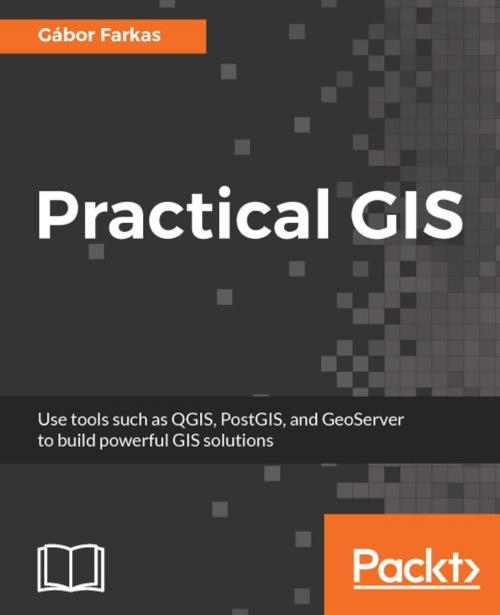| Author: | Gabor Farkas | ISBN: | 9781787128514 |
| Publisher: | Packt Publishing | Publication: | June 13, 2017 |
| Imprint: | Packt Publishing | Language: | English |
| Author: | Gabor Farkas |
| ISBN: | 9781787128514 |
| Publisher: | Packt Publishing |
| Publication: | June 13, 2017 |
| Imprint: | Packt Publishing |
| Language: | English |
Learn the basics of Geographic Information Systems by solving real-world problems with powerful open source tools
About This Book
- This easy-to-follow guide allows you to manage and analyze geographic data with ease using open source tools
- Publish your geographical data online
- Learn the basics of geoinformatics in a practical way by solving problems
Who This Book Is For
The book is for IT professionals who have little or no knowledge of GIS. It's also useful for those who are new to the GIS field who don't want to spend a lot of money buying licenses of commercial tools and training.
What You Will Learn
- Collect GIS data for your needs
- Store the data in a PostGIS database
- Exploit the data using the power of the GIS queries
- Analyze the data with basic and more advanced GIS tools
- Publish your data and share it with others
- Build a web map with your published data
In Detail
The most commonly used GIS tools automate tasks that were historically done manually—compiling new maps by overlaying one on top of the other or physically cutting maps into pieces representing specific study areas, changing their projection, and getting meaningful results from the various layers by applying mathematical functions and operations. This book is an easy-to-follow guide to use the most matured open source GIS tools for these tasks.
We'll start by setting up the environment for the tools we use in the book. Then you will learn how to work with QGIS in order to generate useful spatial data. You will get to know the basics of queries, data management, and geoprocessing.
After that, you will start to practice your knowledge on real-world examples. We will solve various types of geospatial analyses with various methods. We will start with basic GIS problems by imitating the work of an enthusiastic real estate agent, and continue with more advanced, but typical tasks by solving a decision problem.
Finally, you will find out how to publish your data (and results) on the web. We will publish our data with QGIS Server and GeoServer, and create a basic web map with the API of the lightweight Leaflet web mapping library.
Style and approach
The book guides you step by step through each of the core concepts of the GIS toolkit, building an overall picture of its capabilities. This guide approaches the topic systematically, allowing you to build upon what you learned in previous chapters. By the end of this book, you'll have an understanding of the aspects of building a GIS system and will be able to take that knowledge with you to whatever project calls for it.
Learn the basics of Geographic Information Systems by solving real-world problems with powerful open source tools
About This Book
- This easy-to-follow guide allows you to manage and analyze geographic data with ease using open source tools
- Publish your geographical data online
- Learn the basics of geoinformatics in a practical way by solving problems
Who This Book Is For
The book is for IT professionals who have little or no knowledge of GIS. It's also useful for those who are new to the GIS field who don't want to spend a lot of money buying licenses of commercial tools and training.
What You Will Learn
- Collect GIS data for your needs
- Store the data in a PostGIS database
- Exploit the data using the power of the GIS queries
- Analyze the data with basic and more advanced GIS tools
- Publish your data and share it with others
- Build a web map with your published data
In Detail
The most commonly used GIS tools automate tasks that were historically done manually—compiling new maps by overlaying one on top of the other or physically cutting maps into pieces representing specific study areas, changing their projection, and getting meaningful results from the various layers by applying mathematical functions and operations. This book is an easy-to-follow guide to use the most matured open source GIS tools for these tasks.
We'll start by setting up the environment for the tools we use in the book. Then you will learn how to work with QGIS in order to generate useful spatial data. You will get to know the basics of queries, data management, and geoprocessing.
After that, you will start to practice your knowledge on real-world examples. We will solve various types of geospatial analyses with various methods. We will start with basic GIS problems by imitating the work of an enthusiastic real estate agent, and continue with more advanced, but typical tasks by solving a decision problem.
Finally, you will find out how to publish your data (and results) on the web. We will publish our data with QGIS Server and GeoServer, and create a basic web map with the API of the lightweight Leaflet web mapping library.
Style and approach
The book guides you step by step through each of the core concepts of the GIS toolkit, building an overall picture of its capabilities. This guide approaches the topic systematically, allowing you to build upon what you learned in previous chapters. By the end of this book, you'll have an understanding of the aspects of building a GIS system and will be able to take that knowledge with you to whatever project calls for it.















